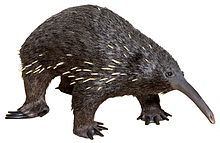Eastern long-beaked echidna
| Eastern long-beaked echidna | |
|---|---|
 |
|
| Zaglossus bartoni (replica at MUSE - Science Museum in Trento) | |
| Scientific classification | |
| Kingdom: | Animalia |
| Phylum: | Chordata |
| Class: | Mammalia |
| Order: | Monotremata |
| Family: | Tachyglossidae |
| Genus: | Zaglossus |
| Species: | Z. bartoni |
| Binomial name | |
|
Zaglossus bartoni (Thomas, 1907) |
|
 |
|
| Eastern long-beaked echidna range | |
The eastern long-beaked echidna (Zaglossus bartoni), also known as Barton's long-beaked echidna, is one of three species from the genus Zaglossus to occur in New Guinea. It is found mainly in Papua New Guinea at elevations between 2,000 and 3,000 metres (6,600 and 9,800 ft).
The eastern long-beaked echidna can be distinguished from other members of the genus by the number of claws on the fore and hind feet: it has five claws on its fore feet and four on its hind feet. Its weight varies from 5 to 10 kilograms (11 to 22 lb); its body length ranges from 60 to 100 centimetres (24 to 39 in); it has no tail. It has dense black fur. It rolls into a spiny ball for defense.
All long-beaked echidnas were classified as a single species, until 1998 when Tim Flannery published an article identifying several new species and subspecies. Three species were then recognized based on various attributes such as body size, skull morphology, and the number of toes on the front and back feet.
There are four recognized subspecies of Zaglossus bartoni :
The population of each subspecies is geographically isolated. The subspecies are distinguished primarily by differences in body size.
Eastern long-beaked echidnas are mainly insect eaters, or insectivores. The long snout proves essential for the Echidna’s survival because of its ability to get in between hard-to-reach places and scavenge for smaller insect organisms such as larvae and ticks. Along with this snout, they have a specific evolutionary adaptation in their tongues for snatching up various earthworms, which are its main type of food source.
Zaglossus bartoni habitats include tropical hill forests to sub-alpine forests, upland grasslands and scrub. The species has been found in locations up to an elevation of around 4,150 m. Today is it rare to find Zaglossus bartoni at sea level.
Zaglossus bartoni is currently listed as Vulnerable on the Red List.Deforestation is one of the factors leading to the decline of this species.
Humans are the main factor in diminishing populations of eastern long-beaked echidnas. Locals in areas surrounding regions that these organisms inhabit often prey upon them for food. Feral dogs are known to occasionally consume this species. These mammals dig burrows, providing some protection from predation.
The eastern long-beaked echidna is a member of the order Monotremata. Although monotremes have some of the same mammal features such as hair and mammary glands, they do not give birth to live young, they lay eggs. Like birds and reptiles, monotremes have a single opening, the cloaca. The cloaca allows for the passage of urine and feces, the transmission of sperm, and the laying of eggs.
...
Wikipedia

